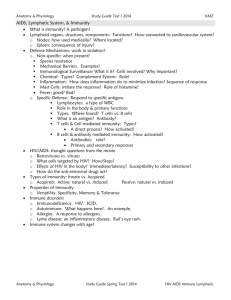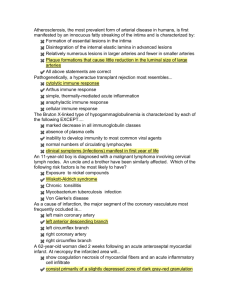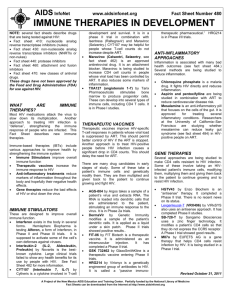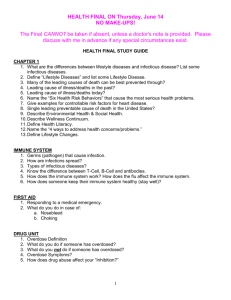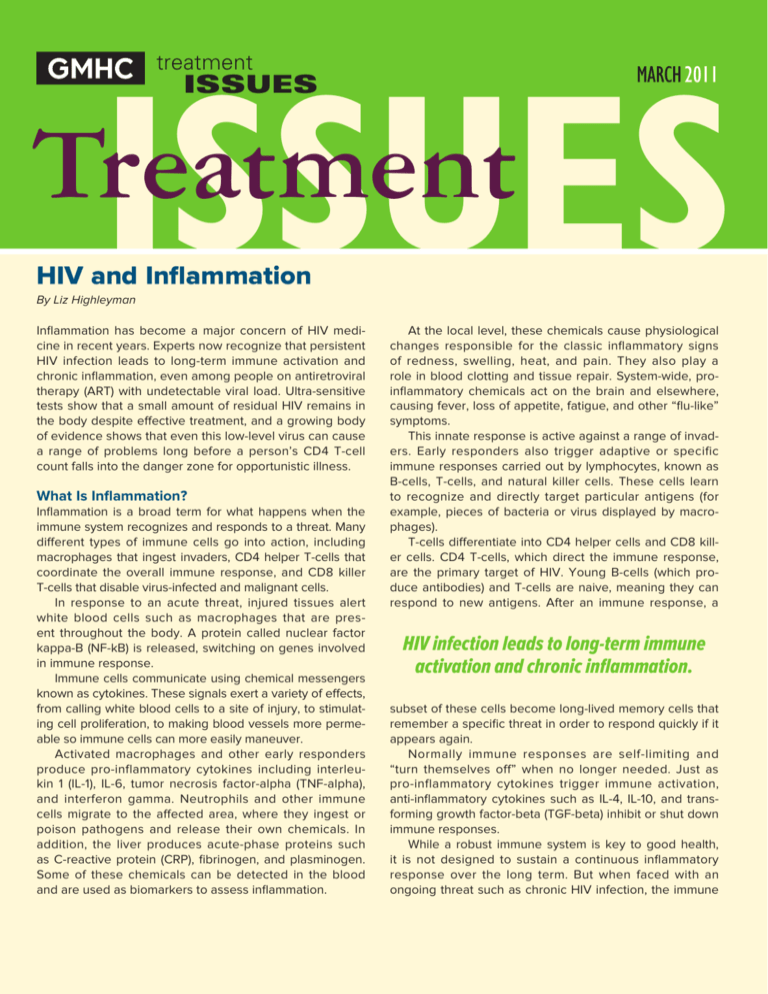
ISSUES
treatment
MARCH 2011
ISSUES
Treatment
HIV and Inflammation
By Liz Highleyman
Inflammation has become a major concern of HIV medicine in recent years. Experts now recognize that persistent
HIV infection leads to long-term immune activation and
chronic inflammation, even among people on antiretroviral
therapy (ART) with undetectable viral load. Ultra-sensitive
tests show that a small amount of residual HIV remains in
the body despite effective treatment, and a growing body
of evidence shows that even this low-level virus can cause
a range of problems long before a person’s CD4 T-cell
count falls into the danger zone for opportunistic illness.
What Is Inflammation?
Inflammation is a broad term for what happens when the
immune system recognizes and responds to a threat. Many
different types of immune cells go into action, including
macrophages that ingest invaders, CD4 helper T-cells that
coordinate the overall immune response, and CD8 killer
T-cells that disable virus-infected and malignant cells.
In response to an acute threat, injured tissues alert
white blood cells such as macrophages that are present throughout the body. A protein called nuclear factor
kappa-B (NF-kB) is released, switching on genes involved
in immune response.
Immune cells communicate using chemical messengers
known as cytokines. These signals exert a variety of effects,
from calling white blood cells to a site of injury, to stimulating cell proliferation, to making blood vessels more permeable so immune cells can more easily maneuver.
Activated macrophages and other early responders
produce pro-inflammatory cytokines including interleukin 1 (IL-1), IL-6, tumor necrosis factor-alpha (TNF-alpha),
and interferon gamma. Neutrophils and other immune
cells migrate to the affected area, where they ingest or
poison pathogens and release their own chemicals. In
addition, the liver produces acute-phase proteins such
as C-reactive protein (CRP), fibrinogen, and plasminogen.
Some of these chemicals can be detected in the blood
and are used as biomarkers to assess inflammation.
At the local level, these chemicals cause physiological
changes responsible for the classic inflammatory signs
of redness, swelling, heat, and pain. They also play a
role in blood clotting and tissue repair. System-wide, proinflammatory chemicals act on the brain and elsewhere,
causing fever, loss of appetite, fatigue, and other “flu-like”
symptoms.
This innate response is active against a range of invaders. Early responders also trigger adaptive or specific
immune responses carried out by lymphocytes, known as
B-cells, T-cells, and natural killer cells. These cells learn
to recognize and directly target particular antigens (for
example, pieces of bacteria or virus displayed by macrophages).
T-cells differentiate into CD4 helper cells and CD8 killer cells. CD4 T-cells, which direct the immune response,
are the primary target of HIV. Young B-cells (which produce antibodies) and T-cells are naive, meaning they can
respond to new antigens. After an immune response, a
HIV infection leads to long-term immune
activation and chronic inflammation.
subset of these cells become long-lived memory cells that
remember a specific threat in order to respond quickly if it
appears again.
Normally immune responses are self-limiting and
“turn themselves off” when no longer needed. Just as
pro-inflammatory cytokines trigger immune activation,
anti-inflammatory cytokines such as IL-4, IL-10, and transforming growth factor-beta (TGF-beta) inhibit or shut down
immune responses.
While a robust immune system is key to good health,
it is not designed to sustain a continuous inflammatory
response over the long term. But when faced with an
ongoing threat such as chronic HIV infection, the immune
response remains engaged, leading to problems throughout the body.
Over time, persistent cytokine elevation and other
immune processes can damage organs including the
heart and brain. Furthermore, continuous activation accelerates progression of immune cells though the cycle
of growth and division, causing them to “burn out” prematurely, a state known as immunosenescence. In an
article published in Topics in HIV Medicine, Steven Deeks
reports that middle-aged HIV-positive people show signs
of immunosenescence resembling those of HIV-negative
people over age 70.[1]
How does HIV Cause Inflammation?
Inflammation is implicated in almost every type of health
problem and its consequences tend to be worse for people with HIV since the ongoing presence of the virus maintains CD4 and CD8 T-cells in a constant state of activation.
Combination ART has dramatically reduced the risk
of AIDS-defining opportunistic illness and death.
But as HIV-positive people
survive longer thanks to
effective treatment, they
are at increased risk for a
variety of non-AIDS conditions even while CD4 cell
counts are relatively high.
At a recent forum, Deeks suggested AIDS should
perhaps be thought of as “acquired inflammatory disease syndrome.” “HIV is causing high-level inflammation and inflammation-associated disease,” he explained.
“Antiretroviral therapy can help people live longer, but it
does not restore health and they do not have a normal
lifespan.” Starting treatment earlier, he said, might mitigate
these effects.
Experts think chronic immune activation and inflammation contribute to higher rates of cardiovascular disease
and other non-AIDS conditions seen in people with HIV.
But given that HIV disease is characterized by immune
suppression, how can it also cause excessive immune
activation and inflammation? The answer lies in the complexity of the immune response. As Peter Hunt and colleagues from the University of California, San Francisco
(UCSF) explained at the 2010 Conference on Retroviruses
and Opportunistic Infections (CROI), “HIV has its foot on
the accelerator and the brakes at the same time.”[2]
While late-stage HIV/AIDS involves severe immune
deficiency, immune activation and dysregulation are more
common at earlier stages. Throughout the course of disease, however, the percentage of infected CD4 T-cells
does not seem large enough to explain the extent of
immune dysfunction. Most CD4 cells in the blood and
lymph nodes of people with chronic infection do not
carry the virus, but it appears that only a small amount is
needed to sustain an inflammatory state. Even “elite controllers,” the small proportion of HIV-positive people who
naturally control the virus without treatment, show greater
immune activation than HIV-negative people, and they are
at higher risk for cardiovascular disease and other nonAIDS conditions.
HIV proteins including Tat and gp120 appear to directly
stimulate immune responses by altering cytokine signaling. HIV also contributes to inflammation in less direct
ways. At the earliest stages of infection, the virus establishes itself in lymphoid tissue in the gastrointestinal tract,
the body’s largest reservoir of susceptible CD4 T-cells.
Brenchley et al. explained in a 2006 report in Nature
Medicine that HIV infection damages the intestinal lining and makes it more permeable, allowing bacteria that
normally reside in the gut to escape, a process known
as microbial translocation. [3] As they enter the bloodstream, these bacteria and a toxin they produce called
lipopolysaccharide (LPS) trigger a strong systemic immune
response.
Viral and bacterial coinfections also play a role in
HIV-related inflammation.
Decreased immune function, even while CD4 cell
counts are still relatively
high, can lead to loss of
control of other diseasecausing organisms in the
body. HIV-positive people
with active chronic viral coinfections, such as herpes simplex virus, cytomegalovirus (CMV), and hepatitis B and C
viruses, typically have higher HIV viral load, lower CD4
T-cell counts, and faster progression to AIDS.
UCSF researchers showed that HIV-positive people with
stronger CMV-specific CD8 T-cell responses had higher
levels of inflammation biomarkers and more early atherosclerosis. At CROI 2010, they reported that treating CMV
with valganciclovir reduced CD8 cell activation.[4] Similarly,
Kovacs et al. found that among HIV-positive women coinfected with hepatitis C, those with the most activated CD8
cells had three times the risk of progression to AIDS.[5]
Finally, metabolic abnormalities such as elevated lowdensity lipoprotein (LDL) cholesterol and body composition changes associated with HIV and its treatment can
trigger inflammation, and these inflammatory changes in
turn can affect metabolism.
While some antiretroviral drugs can contribute to metabolic abnormalities, the overall effect of ART is to reduce
inflammation. Experts advise that lowering viral load as much
as possible is the most effective way to reduce persistent
immune activation and inflammation in people with HIV.
Chronic immune activation and inflammation
contribute to higher rates of cardiovascular
disease in people with HIV.
2
Inflammation Biomarkers
It is increasingly clear that complications seen in HIVpositive people are not only due to the effects of the virus
on the immune system, but also the immune system’s
response to the virus. The idea that persistent immune activation and inflammation influence HIV disease progression
is not new. Since the early years of the epidemic, research-
MARCH 2011
ers have reported that HIV-positive people have elevated
levels of various markers of inflammation. Hunt et al. have
shown that greater T-cell activation predicts faster CD4
cell decline among untreated people, and poorer CD4 cell
recovery on ART despite viral suppression.[6]
The large Strategies for Management of Antiretroviral
Therapy (SMART) treatment interruption trial prompted
the latest wave of interest in HIV-related inflammation and
its consequences. SMART enrolled more than 5,000 HIVpositive adults with a CD4 count above 350 cells/mm3.
They were randomly assigned either to stay on continuous
ART or to stop treatment when their CD4 count rose above
this level, resuming when it fell below 250 cells/mm3.
The treatment interruption arm was halted ahead
of schedule in January 2006 after an interim analysis
showed that these participants not only had a higher rate
of opportunistic illness and death, but also were at higher
risk for serious non-AIDS conditions including heart, liver,
and kidney disease. These
results, and those of subsequent studies, led to
an intensive search for an
explanation. Researchers
began looking at biomarkers of increased inflammation, coagulation, and
endothelial (blood vessel
lining) dysfunction.
At the 2008 CROI and in a follow-up report in PLoS
Medicine, Lewis Kuller and colleagues from the SMART
team reported that elevated levels of the pro-inflammatory
cytokine IL-6, the coagulation marker D-dimer, and the
acute-phase protein CRP were associated with increased
cardiovascular mortality and all-cause mortality.[7] IL-6 and
D-dimer rose along with viral load after treatment interruption, but remained stable in people on continuous therapy.
The Swiss-Thai-Australia Treatment Interruption Trial
(STACCATO), in which participants restarted ART when
their CD4 count fell below 350 cells/mm3 (rather than
250 cells/mm3 in SMART), also revealed a link between
HIV viral load and inflammation biomarkers.[8] A variety
of markers, including D-dimer, VCAM-1, P-selectin, MCP1, and leptin, decreased as HIV was suppressed on ART
and rose during treatment interruption. In contrast, levels
of anti-inflammatory biomarkers, including IL-10 and adiponectin, increased as viral load declined and fell during
treatment breaks.
In a comparison of inflammation biomarkers in people
with and without HIV, Neuhaus et al. looked at SMART
participants and HIV-negative individuals in two large population-based cardiovascular studies, Multi-Ethnic Study of
Atherosclerosis (MESA) (age 45–76) and Coronary Artery
Risk Development in Young Adults (CARDIA) (age 33–44).[9]
People with HIV had significantly higher levels of markers
including IL-6, CRP, and D-dimer. Levels were higher in
HIV-positive participants both on and off ART compared
with HIV-negative people, and this link remained after
adjusting for traditional cardiovascular risk factors.
While SMART revealed more inflammation among participants who interrupted ART, even people on continuous
ART with stable suppressed viral load have higher inflammation biomarker levels than HIV-negative individuals.[10]
Furthermore, Baker et al. recently reported increased
inflammation biomarkers in HIV-positive people who still
have high enough CD4 cell counts that they do not yet
need treatment. [11] Indeed, even elite controllers show
more inflammation than HIV-negative people.
In summary, it is now widely acknowledged that HIV
has harmful effects well before it causes serious immune
deficiency, and these effects can persist despite undetectable viral load and high CD4 cell counts.
Consequences of Inflammation
Changes in biomarker levels reflect physiological processes that can ultimately lead to serious clinical consequences. Not long after the advent of effective combination
ART, researchers began to
notice that as HIV-positive
people lived longer, they
were at higher risk for
chronic progressive conditions such as cardiovascular disease, kidney disease,
bone loss, neurocognitive
impairment, and certain
non-AIDS-related cancers.
Numerous studies have shown that these age-related
conditions are associated with elevated levels of inflammation biomarkers. HIV infection has been shown to promote
immunosenescence and many people with HIV and their
doctors have noted that the virus seems to accelerate aging
in general. HIV-positive individuals tend to develop these
progressive conditions sooner than their HIV-negative counterparts. For example, people with long-term HIV infection
have brain function similar to that of HIV-negative people
15–20 years older, on average, while blood vessel function
resembles that of people 10 years older.[12]
Large general population studies have shown that
blood levels of inflammatory chemicals involved in atherosclerosis, or “hardening of the arteries,” can predict
future cardiovascular events. Not coincidentally, these are
the same biomarkers linked to cardiovascular events and
death in SMART and other studies of people with HIV.
Observational studies since the advent of ART in the
mid-1990s have seen higher rates of cardiovascular disease among people with HIV. This may be attributable to
the virus itself, antiretroviral drugs, greater frequency of
risk factors such as smoking, or some combination of factors, with inflammation playing a key role.
As described at CROI 2010, Priscilla Hsue and her
team at UCSF found that HIV-positive people experienced faster atherosclerosis progression, as measured by
intima-media thickness, or thickness of blood vessel walls,
than HIV-negative individual over two years.[13] This was
the case for people with undetectable viral load on ART
and even for elite controllers. People with HIV also had
Age-related conditions are
associated with elevated levels
of inflammation biomarkers.
GMHC GMHC.ORG
3
treatment
ISSUES
ISSUES
Treatment
Editor: Robert Valadéz
Assistant Editors: Sean Cahill, Nathan Schaefer
Art Director: Adam Fredericks
GMHC Treatment Issues
is published by GMHC, Inc.
All rights reserved.
Non­commercial reproduction is encouraged.
GMHC Treatment Issues
The Tisch Building
119 W. 24th Street, New York, NY 10011
gmhc.org
© 2011 Gay Men’s Health Crisis, Inc.
Support for GMHC Treatment Issues
was made possible through educational grants
or charitable contributions from the following:
The Shelley & Donald Rubin Foundation
impaired ability of arteries to respond to changes in blood
flow.[14] Both measures were associated with inflammation,
as indicated by elevated CRP levels.
At the same meeting, Robert Kaplan and colleagues
reported that increased carotid artery intima-media thickness and reduced distensibility (ability of blood vessels to
expand) were linked to greater CD4 and CD8 cell activation and T-cell senescence in HIV-positive women.[15]
Looking at actual clinical events among patients
at Massachusetts General Hospital and Brigham and
Women’s Hospital in Boston, Triant et al. found that HIVpositive people with high CRP had four times greater risk
of myocardial infarction than HIV-negative people with
normal CRP . [16] More recently, Phyllis Tien and fellow
investigators with the Fat Redistribution and Metabolic
Change in HIV Infection (FRAM) study reported that HIVpositive people with elevated CRP and fibrinogen had a
significantly higher risk of death over five years.[17]
While the detrimental effects of inflammation have
been most clearly demonstrated for cardiovascular disease, similar associations are seen for cognitive impairment, non-AIDS-related cancer, and other progressive
age-related conditions.
Managing Inflammation
The initial goal of HIV medicine was simply to keep people
alive by managing opportunistic illnesses, and over time
shifted to viral load suppression and managing ART side
effects and complications. Today, the focus is on improving overall health and enabling HIV-positive people to live
as long as their HIV-negative counterparts.
4
A number of different strategies have been proposed
for managing inflammation in people with HIV. As noted,
optimizing ART to keep viral load as low as possible for as
long as possible, as well as treatment of coinfections, are
the most reliable current approaches. Numerous studies
have shown that suppressing HIV decreases T-cell activation and reduces inflammation biomarkers, while stopping
ART worsens inflammation. Managing inflammation is
a major rationale for the current trend toward earlier
treatment.
Researchers have looked at a wide variety of antiinflammatory and immune-suppressing agents for managing inflammation in HIV-positive people. Many of these
work by altering production or activity of cytokines. Some
researchers are particularly interested in CCR5 antagonists, drugs that prevent HIV from using the CCR5 coreceptor to enter cells. CCR5’s role in immune response is
not fully understood, but drugs like maraviroc (Selzentry)
appear to have anti-inflammatory as well as antiretroviral
properties. Some clinical trials of maraviroc have shown
that even though it does not suppress HIV better than
other antiretroviral classes, it appears to produce larger
CD4 cell gains, reduce T-cell activation, and decrease
inflammatory biomarkers.[18, 19, 20]
At CROI 2010 and at the XVIII International AIDS
Conference this past July, researchers presented data
on a novel experimental drug, TBR-652, that blocks both
CCR5 and CCR2 cell surface receptors. Early studies
suggest it has anti-inflammatory as well as antiretroviral
activity.[21]
But interfering with immune response can be dangerous in people who have HIV, which already suppresses
immune function. Furthermore, there is potential for unintended consequences when altering cytokine activity and
other cell-signaling pathways that are not fully understood.
A safer approach involves lifestyle changes to reduce
inflammation, including smoking cessation, weight loss,
diet modification, exercise, adequate sleep, and stress
management.
Conclusion
Over the past few years, researchers have learned a great
deal about inflammation and its relationship to HIV. Today,
studies routinely collect data about biomarkers and other
indicators of inflammation and immune activation, and
clinicians are starting to think about how such measures
could be applied in real-world patient care.
Inflammation may ultimately prove to be the key that
unlocks some of the mysteries of HIV disease. In turn,
advances in HIV medicine may contribute to the development of anti-inflammatory approaches that will also benefit
people with other diseases.
Liz Highleyman is a freelance medical writer specializing
in HIV and hepatitis.
For a full list of references, please visit: gmhc.org/research/
treatment-issues
MARCH 2011


